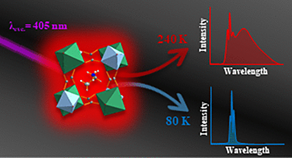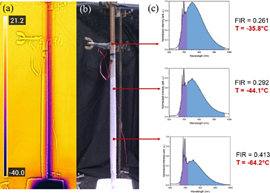Metal–Organic Framework Optical Thermometer Based on Cr3+ Ion Luminescence
Title: Metal–Organic Framework Optical Thermometer Based on Cr3+ Ion Luminescence
Autorhs: A. Kabański*, M. Ptak, D. Stefańska*
Journal: ACS Applied Materials & Interfaces

The research presented in the publication entitled: “Metal–Organic Framework Optical Thermometer Based on Cr3+ Ion Luminescence” are related to the implementation of the NCN project SONATA-16 UMO-2020/39/D/ST5/01289, headed by Dr. Dagmara Stefańska.
Meal-organic frameworks (MOFs) have recently attracted increasing attention from the scientific community due to their interesting structural, magnetic, dielectric, optical, and phonon properties. This group of materials includes, among others, compounds with a perovskite-type structure with the general formula ABX3, where A is an organic cation, B is a metal cation, and the position of anion X is occupied by a small inorganic or organic linker.
This work focuses on the structural and luminescent studies of a series of six heterometallic perovskite-type organometallic structures with the formula [EA]2NaCrxAl1 – x(HCOO)6, where x = 1; 0.78; 0.57; 0.30; 0.21 or 0. The conducted studies showed a strong influence of the sample composition on the structural, phonon, and spectroscopic properties. It was shown that the strength of the crystal field (Dq/B) around Cr3+ ions and the size of the energy band gap (Eg) decrease with increasing chromium ion content. The emission properties of Cr3+ ions change significantly in the range of 80-250 K, and the coexistence of spin-forbidden 2E→4A2g and spin-allowed 4T2g→4A2g emissions allows for a non-contact temperature sensing.
This is the first report showing the potential of hybrid organic-inorganic perovskites as luminescent thermometers based solely on the luminescence of Cr3+ ions. The correlation between the composition of the sample and the sensitivity of the obtained thermometer was presented. In addition, the practical application of the obtained compounds was demonstrated. The first tests were carried out on a simple setup using a temperature gradient in a copper pipe with one end immersed in liquid nitrogen.

See also
- The Institute
- General information
- Employees
- News
- Scientific News
- Gender equality plan
- Address and contact data
- Research
- Research profile
- List of publications
- List of projects
- International cooperation
- Information in BIP
- Scientific Council
- Organizational structure
- GDPR


